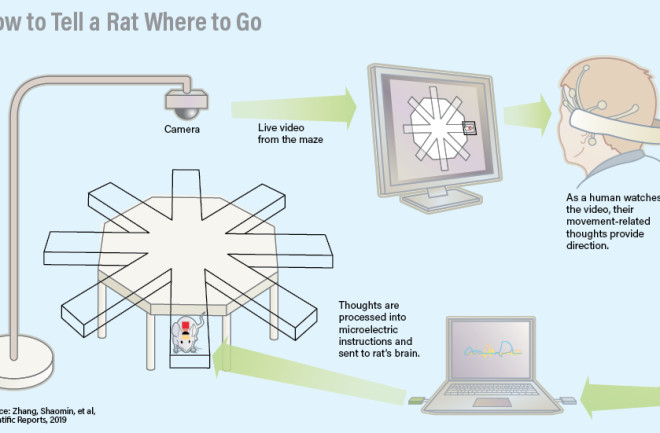In February, a very real paper ran in Scientific Reports titled, “Human Mind Control of Rat Cyborg’s Continuous Locomotion with Wireless Brain-to-Brain Interface.” It described how existing technology — such as brain-brain interfaces (BBIs) and, incredibly, rat cyborgs — can work together to produce that eye-popping title.
BBIs and brain-machine interfaces (BMIs) have already helped improve how people control prosthetics and other devices. But the technology can also function the other way around — instead of a brain controlling a device, a machine can alter brain patterns or “import tactile information back to the brain,” as the study’s authors put it. So, in effect, BMIs could allow for mechanically “controlling” others’ brains.
Here’s how it works in practice: A human manipulator has movement-related thoughts, which a wearable EEG — a device that records brain wave patterns — picks up and transfers to a computer. The computer translates that signal into “control instructions” and wirelessly beams them into a receiver on the back of a rat. The receiver then sends them into the rat’s brain via pre-installed electrodes. And the rat responds to the instructions in its brain by actually doing them.
“With this interface, our manipulators were able to mind control a rat cyborg to smoothly complete maze navigation tasks,” the authors write.
I know what you’re thinking (a chilling phrase given the context): Is this for real?
“[The study] is for real, and I don’t see anything implausible about it,” says University of Washington brain researcher Andrea Stocco, who was not involved with the work. He suggests the tech could be useful for improving augmented reality systems or even helping an expert surgeon remotely control a local doctor’s hands in a delicate operation.
But, he says, “the holy grail of BBI would be sharing rich content that cannot be better expressed in words, such as emotions and feelings. We are still so far from that, but, of course, that would be the dream.”

